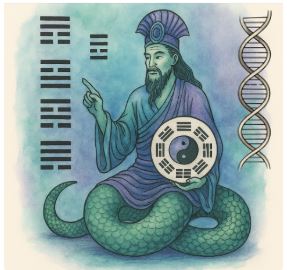The I Ching – The Book of Changes

The I Ching, or Book of Changes, is both a philosophical and spiritual guide, offering wisdom for understanding the ever-shifting nature of reality and for living with clarity and harmony within life’s flow. It is not a doctrine of gods or rigid moral laws, but a symbolic language of patterns and movements. Through this language, we are invited to perceive our current situation, recognize directions of change, and choose actions aligned with the natural rhythms of existence.
At its heart, the I Ching is built on 64 hexagrams—figures composed of six stacked lines, either whole or broken:
Whole line (⚊): Yang – activity, clarity, initiative, dynamic masculine energy.
Broken line (⚋): Yin – receptivity, softness, stillness, nurturing feminine energy.
Each hexagram represents a potential life condition or state of consciousness, offering guidance for transformation and growth. By casting three coins or yarrow stalks, a hexagram emerges to reflect the present moment, with a second cast often pointing toward the movement of change. The very act of contemplation becomes a catalyst for new awareness.
The wisdom of the I Ching rests on principles of balance, cycles, transformation, and interconnection. These insights, formed more than 3,000 years ago, continue to resonate with modern thought. Philosophers, scientists, and psychologists—among them Carl Jung—recognized in the I Ching a universal language of patterns and consciousness. Some researchers have even noted structural parallels between its 64 hexagrams and the 64 codons of the genetic code, suggesting a profound link between the symbolic language of the cosmos and the biological language of life.
Ultimately, each hexagram can be seen as a six-bit binary code, producing 64 possible combinations. Each one acts as a key to understanding the dynamic interplay of inner and outer life, both personal and collective.